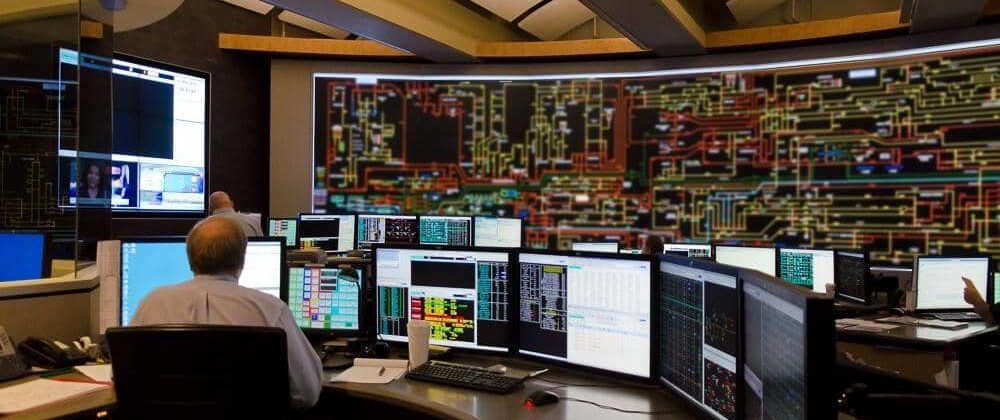The quality and features of your control room furniture have a significant impact on the daily operations and performance of your utility company. There are many consequences of choosing the wrong furniture, including operator discomfort, poor decision making, and overall inefficiency.
Finding the right technical furniture for your organization requires an in-depth look at your everyday operations, current operator needs, and future business goals. To help you make the best decision, we’ve created a guide for choosing the most important pieces of control room furniture.
Ergonomic 24/7 Chairs
Keeping operators comfortable throughout long shifts is of the utmost importance, so your 24/7 chairs must incorporate ergonomic design. Utility personnel make important decisions that impact large numbers of people, so they must be relaxed and undistracted. Sustained comfort is also important because operators typically have fewer opportunities for breaks than other employees.
It’s important to remember that 24/7 chairs are shared by people with a variety of different heights, weights, and body types. As a result, your seats should have full adjustment capabilities and be intended specifically for use in control room settings. Ultimately, technical furniture for command centers supports operators as they monitor displays, access controls, and make real-time decisions.
Look for These Features
Here are a few important features you should look for when choosing 24/7 chairs for your control room:
- Heavy-duty weight capacities (300 pounds minimum)
- Footrests to support operators’ feet and legs
- Headrests to help prevent tension headaches
- Thick, padded seats
- Padded arms
- Knee tilt mechanisms
- Casters for stability and ease of movement
- Tall backs that provide neck support to reduce strain
- Mechanisms designed to prevent muscle cramps, back pain, and poor posture
Control Room Console Furniture & Workstations
The desks and workstations used inside control rooms, operator consoles integrate specialized IT equipment and must withstand around-the-clock use. Operators spend 8-20+ hours a day in your utility control room, so it’s very important that the space meets their needs.
Custom control room furniture – particularly consoles – boosts efficiency and productivity by removing potential discomforts. Ergonomically-designed consoles can also help prevent workplace injuries and positively impact operator productivity, job performance, and decision making.
Console Types
There are two main types of control room console furniture: single surface and single surface with actuating focus rails. We’ll take a closer look at each of these below.
With single surface consoles, the keyboard and monitor(s) are located on the same surface. These products can be fixed or height adjustable and are a cost-effective choice for organizations on a budget. Be sure to choose consoles with sturdy leg systems that can support IT equipment, monitors, and the work surface itself.
On the other hand, single surface consoles with actuating focus rails reduce desk pinch points while providing a strong, stable surface for monitors. Regardless of the command center desks you choose, your personnel should have unobstructed views of relevant monitors and video walls for quick collaboration and/or visual confirmation of relevant data.
IT Requirements
Dual surface control room console furniture is designed to support multiple computers and large monitors using a tiered setup. You can choose from a variety of custom control room furniture for PC housing, including dynamic systems that move with your work surface or expandable options.
Be sure to consider the type and quantity of computers needed for each workstation when choosing operator consoles. You’ll also want to pay attention to the configuration of your control room, including the location of video walls and storage areas.
Depending on your specific needs, your operator consoles should include any or all of the following features:
- Accessible cable storage and management systems (e.g. sliding desktops or cable chains)
- Sturdy arms to support multi-tiered monitor setups
- Plenty of power and data outlets
- Quick-connect plugs
- Storage space for PCs and other IT equipment

Sit-Stand Capabilities
Your control room furniture design should also have sit-stand capabilities, which allow operators to adjust their workstations to the height that’s most comfortable for them. These multipurpose products accommodate personnel of any height or body type, and they’re also a cost-effective option because they support both sitting and standing.
Operator consoles with sit-stand capabilities also help prevent back strain, reinforce good posture, and keep joints in alignment. You can even add soft console nosing with a waterfall edge to support employees as they lean against their consoles and soft anti-fatigue foot mats to absorb body strain.
Heating & Cooling Controls
Everyone has different temperature comfort levels, so your control room console furniture should include individual heating and cooling controls. This can include features such as user-adjustable ventilation controls and individual radiant heaters.
Task Lighting
Your operator consoles should also feature task lighting that can be adjusted based on individual preferences. Inadequate lighting can lead to eye strain, while too much illumination can cause headaches or cast a painful glare.
Dimmable task lighting allows personnel to evenly light their work surface without negatively impacting operators at neighboring consoles. It also promotes overall situational awareness by helping your employees perform their jobs efficiently and make better decisions in real time.
Console Cabinets
Console cabinets house all of your hardware in a safe, convenient place while protecting your overall operational security. These control room furniture items also free up much-needed floor space to improve overall efficiency and flow. Finally, console cabinets eliminate clutter and distractions by providing a secure place to organize and connect your IT equipment.
You can customize your console cabinets in a variety of configurations to ensure your technology is operating at maximum performance. And if you need to store additional equipment down the road, you can easily add more console cabinet space.

Conference Tables
When it comes to utility and industrial control room furniture, be sure to select your conference tables wisely. This technical furniture facilitates essential internal conversations and also provides working space for meetings with suppliers and customers. You’ll find a few of the most important things to keep in mind when choosing a conference table in the following sections.
Appearance
Your conference table should maximize the functionality of your space while matching the design of the rest of your furniture and providing an aesthetic appeal. Look for tables made from materials that are easy to maintain and resistant to scratches, shocks, and high temperatures.
Number of Seats
Determining the number of chairs you’ll need for your conference table starts with figuring out the overall room capacity. You’ll also need to consider how the types of chairs you’ve chosen will fit around the table. Always keep employee and guest comfort in the forefront of your mind by giving them ample space to work and maneuver.
Power & IT Integration
It’s important to consider the type and number of power sources you need and how these features will affect the function of your table. There should be electrical outlets and USB ports for everyone, along with built-in presenter controls that facilitate screen sharing.
You may also want to incorporate monitors mounted under the tabletop with panes of protective glass. Integrated cable management systems, height adjustment capabilities, and easy access to network equipment also further the convenience and functionality of your conference table.
Room Size
There should always be adequate space to comfortably move chairs away from the conference table and provide access to all areas of the room. Doors and windows should be easily reachable, along with other furniture and/or audiovisual equipment.
Table Type
Conference tables are available in a wide variety of sizes and shapes, including horseshoe, square, rectangular, and oval. You can also choose from tables with folding legs, fixed tables, and tables on wheels with flip tops. Ultimately, your conference table should be expandable and reconfigurable to match your evolving organizational needs.

Acoustic Panels
Designed to absorb sound and minimize operator distractions, acoustic panels can be mounted to the ceiling of your command center, arranged in the middle of the room, or placed between operator consoles. Look for products with high pores per inch (PPI) ratings, as they offer the best sound absorption and diffusion. You can also install privacy panels between consoles to block unwanted sound and light.
Choose Fully-Customized Operator Consoles From Mauell
If you’re ready to purchase control room furniture for your new or recently renovated command center, we’ve got you covered. At Mauell, we provide state-of-the-art control room consoles for round-the-clock environments that combine the highest-quality materials with proven ergonomics.
We specialize in designing and building custom consoles that satisfy your unique operational needs, fit within your existing space, and satisfy all industry standards. Your new equipment will maximize operator health and efficiency by focusing on ergonomics, safety, and environmental comfort.
Your customized operator consoles can be built to include any or all of the following features:
- Sit-stand capabilities
- Monitors that lift and lower themselves
- Personal heating and cooling systems
- Non-reflecting workspaces
- Touchpads to control room lighting, audio levels, and adjust video and monitors
- Rotating PC trays, advanced cable management systems, cooling vents, and customizable slat walls to support equipment arms, platforms, and binder shelves


